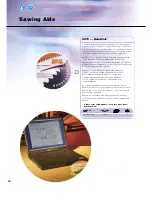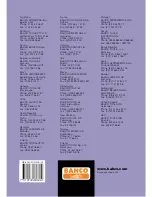
30
Troubleshooting Guide
Important Facts
Band Breakage
Crooked Sawing
Guides and guide arms
Guides too far apart
Check and adjust the guides regularly.
Guides worn out
Guides worn out
Check if worn out and replace if necessary.
Guide setting too wide
Guide arm loose
Position guide arms as close to the workpiece as possible.
Guides poorly adjusted
Band wheels
Worn band wheel
The wheels have to be kept in good condition and
Too small band wheels
should be properly aligned.
– try thinner bands
Chip brush
Check that the chip brush is properly adjusted and
change it regularly.
Band tension
The correct band tension is needed to get a straight cut.
Band tension too high
Band tension too low
Measure with the Bahco tensionmeter.
Coolant/Cutting fluid
The coolant is needed to lubricate and to cool.
Check the concentration with a refractometer
Use a good coolant. It should reach the cut with
low pressure and with a generous flow.
Band speed
The band speed has to be correctly chosen,
Band speed too low
see chart on page 8.
Check the band speed using the Bahco tachometer.
Feed rate
The feed rate has to be chosen so that the teeth of
Feed rate too high
Feed rate too high
the bandsaw blade can work properly, see page 8.
Tooth pitch
The selection of the right pitch of the blade is just as
Tooth pitch too fine
Tooth pitch too fine
important as choosing the correct feed and speed.
See page 9 and 10.
Tooth shape
Every tooth has its ideal application.
To select the right one, consult page 11.
Running in
A new bandsaw blade should be run in to obtain maximum
bandsaw tool life. (see page 7) Never saw in old kerf.
Blade life
All blades wear out eventually. Look for signs of wear.
Band worn out
Surface
The surface quality of the workpiece will strongly
influence the life of the blade. If the surface is bad, lower
the band speed.
Clamping
Make sure the workpieces are securely clamped. This is
especially important when cutting bundles.
Do not use bent or damaged workpieces.
Machine
Cutting Data
Bandsaw Blade
W
o
rkpiece





































